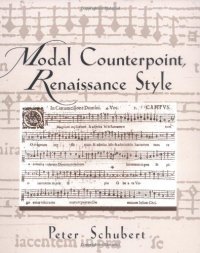
Ebook: A Creative Approach to Music Fundamentals
Author: William Duckworth
- Year: 2006
- Publisher: Thomson/Schirmer
- City: Belmont, CA
- Edition: 9th ed
- Language: English
- pdf
An exceptional text for undergraduate and graduate music students, Modal Counterpoint, Renaissance Style uses a wide variety of carefully graded exercises to present guidelines for writing and analyzing 16th-century music. The only species counterpoint text that draws directly on Renaissance treatises, it provides a conceptual framework to guide students through composition and analysis as it teaches them general structural principles. With stylistically diverse examples including not only motets and mass movements but also French chansons, German chorale settings, English canzonets, Italian madrigals, and Spanish organ hymns, villancicos, and ricercars, the book gives students a "real-life" feel for the subject. It distinguishes between technical requirements ("hard" rules) and stylistic guidelines ("soft" rules), and includes coordinated exercises that allow students to develop their skills systematically. The concluding chapters provide the formal and conceptual building blocks for longer pieces and encourage students to understand analysis and composition as complementary activities. By the end of the book, they are writing real compositions, not just drill exercises. Modal Counterpoint, Renaissance Style features carefully chosen contemporaneous musical examples, progressively graded exercises, historical asides that explain important topics and issues of the period, and a set of notes to the instructor. Combining the historical accuracy of "style-oriented" texts with the more systematic species counterpoint approach, this book offers a unique alternative to other methods Introduction. The elements of music ; The characteristics of musical sound ; Musical talent, musical knowledge ; A theory of music ; How to practice -- The basics of music. Rhythm ; Pitch ; The keyboard ; Accidentals ; Practicing revisited -- Rhythm I : simple meter. Dotted notes ; Time signatures ; Simple meter ; A counting method for simple meters ; Common time and alla breve ; Tempo -- Focus on skills I -- Rhythm II : compound meter. Compound meter ; A counting method for compound meter ; Ties ; Syncopation ; Repeat signs -- Pitch. Enharmonic pitches ; Ledger lines ; The octave sign ; Octave identification ; Stems ; Dynamics ; How to read a musical map ; Rhythm revisited : pulse and beat -- Focus on skills II -- Major scales. Scales as interval patterns ; Elements of the major scale ; Naming scale degrees ; Ear training ; Rhythm revisited : beams -- Major key signatures. The key signature ; Enharmonic keys ; The circle of fifths : major keys ; Rhythm revisited : triplets and duplets ; A counting method for triplets and duplets -- Intervals. Interval identification ; Perfect intervals ; Major and minor intervals ; Compound intervals ; Harmonic inversion of intervals -- Focus on skills III -- Minor key signatures. Related keys ; Minor key signatures ; Parallel keys ; The circle of fifths : minor keys ; Rhythm revisited : conducting patterns -- Minor scales. Natural minor scale ; Harmonic minor scale ; Melodic minor scale ; Minor scales in actual music ; How to sing minor scales -- Pentatonic and blues scales. The pentatonic scale ; The blues scale ; Rhythm revisited : keeping the beat -- Focus on skills IV -- Triads. Basic structure of triads ; Major and minor triads ; Close and open positions ; Augmented and diminished triads ; Triads and scales ; Inversions of triads ; Labeling inversions -- Triads in a musical context. Labeling triads ; Seventh chords ; Recognizing triads in actual music -- Chord progressions. Tendency tones ; The dominant/tonic relationship ; Cadences ; SImple chord progressions -- Focus on skills V. Writing a song. Primary and secondary chords ; Harmonizing a melody ; Musical form -- Graded rhythms for counting and performing -- Graded world rhythms in two and three parts -- Syllables for sight-singing scales and modes -- Graded melodies for sight-singing and playing -- Chromatic scale and major scale fingerings for keyboard instruments -- The C clef -- Other scales and modes -- Transposing the modes -- A brief introduction to timbre -- A brief discussion of acoustics -- Basic guitar chords
Download the book A Creative Approach to Music Fundamentals for free or read online
Continue reading on any device:

Last viewed books
Related books
{related-news}
Comments (0)